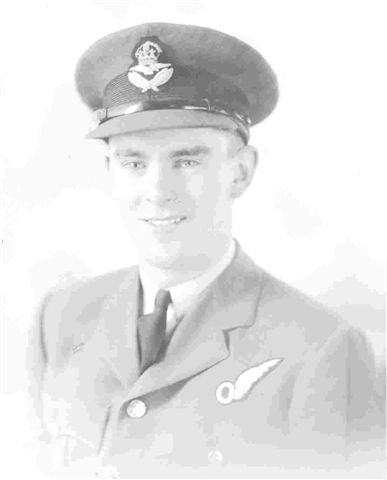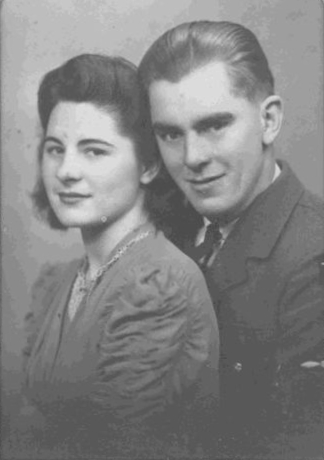 Aircrew Chronicles
Aircrew Chronicles  |
Aircrew Losses
|
Nose Art
|
BCATP
|
Lancaster
|
Media
|
Aircrew Losses
|
Nose Art
|
BCATP
|
Lancaster
|
Media
 Aircrew Chronicles
Aircrew Chronicles  |
Aircrew Losses
|
Nose Art
|
BCATP
|
Lancaster
|
Media
|
Aircrew Losses
|
Nose Art
|
BCATP
|
Lancaster
|
Media
Bomber Command Aircrew Chronicles
|
Kenneth Earnshaw was born in Bridlington, Yorkshire, England, on June 23, 1918, the son of Joseph George Earnshaw and Janet Hannah Green. The Earnshaw family moved to Canada in 1919 and settled in the Thirlmere District, northeast of Ohaton, Alberta. Joseph and Hannah Earnshaw were farmers, and Ken, along with his sister Nora, grew up in a rural community. Ken attended public school at Green Grove, a rural Alberta school, and high school in Camrose, Alberta. During 1938 and 1939 he enrolled in Edmonton Normal School where he obtained his teaching certificate. From Sept. 1, 1939 until June 30, 1941 Ken was employed by Camrose School District #20 and taught at Whitebush School near Bashaw, Alberta. On May 23, 1941, even before the school term had ended, Ken traveled to Edmonton, Alberta and enlisted in the Royal Canadian Air Force. During his training he made stops at Regina and Mossbank, Saskatchewan, Brandon and Rivers, Manitoba, and Halifax, Nova Scotia. Ken married Mary Gladys Heather in Regina on November 7, 1941. He received his Air Observers Badge on February 28, 1942, and was promoted to Flying Officer on April 4, 1942. Ken's ship left Halifax on May 1, 1942 and arrived in England on May 12, 1942. After additional training in England, Ken joined #50 Squadron on Nov. 1, 1942 and flew 30 operations prior to joining #617 Squadron on April 29, 1943. These letter excerpts outline some of Kens' thoughts concerning his overseas experiences. May 13, 1942 - "Dear Folks: Just a few lines to say Hello and let you know I am still alive and kicking. We arrived at our station here yesterday and will be here for quite awhile I think. We are staying at a hotel and are very comfortable. The government has taken over most of the hotels and is using them to billet the Canadian airmen when they first arrive from Canada. Yesterday we saw some of the bombed places. They really were smashed up. The town we saw had taken a terrific beating. When we saw all of the damage that Jerry had done it made us all glad to be over here and perhaps get a chance to get even for all those poor people who could do nothing to defend themselves. The trip over was very uneventful. We were not even sea sick, which was one thing we really were afraid of. There are so many things one cannot tell, that it is very hard to say anything without putting our foot in it and saying something really wrong." October 26, 1942 - "Things here are much the same. We don't do an awful lot but when you figure we may give our life any day I suppose we do enough. We are at a nice place now and like it fine. We also like our new four motored bomber real well too. I guess we should be able to fool them all somehow, and get back safely to Canada when the show is all over. We are fairly near town so we go to a few dances and shows which help break the monotony of this darn Air Force life. It's hard to keep cheerful over here though, for the day of our returning seems so very, very far away sometimes. We went on a big raid to the Rhine sometime ago. It was very exciting, but otherwise uneventful - no stray bullets hit our kite - thank God! I'll tell you all about it when I return to Canada. Several of our boys have been killed over here in crashes and whatnots. Our course (Air Observers Course) seems to be getting lots of hard bangs. One of the fellows I flew with in Canada is gone too!" |
 Ken Earnshaw 1942.  Mary & Ken Earnshaw 1941. |
February 9, 1943 - "Before we went on leave we had two very exciting trips to Germany. On the first our bomber was hit by heavy flak. We got several holes in it but no one was hurt. A few days later we again went out and got quite a dose of it. First flak got us, and then a fighter came roaring along. We just saw him in time, but even at that he got in quite a burst at us. Our mid upper gunner was hit and our plane was riddled with bullet holes. We managed, however, to get home okay and the wounded gunner is doing fine too. It could have been a lot worse. Well, I guess that's about enough war news for one day. I guess as long as one is around to tell of these things they really aren't that bad, are they? Ha! Ha!"
April 7, 1943 - "There really is little new here. I've done 24 trips now so I'm rather looking forward to the end and a rest for awhile at least. I've been to Berlin 3 times now and Essen 4 times, so I should hope I've got my share of tough places over with for awhile. Oh yes, I got my other stripe the other day, so I'm a Flying Officer now. It means another 75 cents a day, so it's okay I guess. Love from Ken!"
Ken Earnshaw had participated in 30 operations prior to joining #617 Squadron on April 29, 1943. During the early morning hours of May 17, 1943, Lancaster ED 925, while participating in the Dambusters raid on the Mohne Dam, was set on fire and crashed about 3 miles S.W. of Soest, Germany.
Bomb aimer, F/Sgt J.W. Fraser, and rear gunner P/O A.F. Burcher DFM, both survived the crash, and were taken Prisoners of War.
Among the five crew members killed were pilot F/LT J.V. Hopgood, DFC, flight engineer Sgt G. Brennan, wireless operator Sgt J.W. Minchin, gunner P/O G.H. Gregory, DFM, and navigator, F/O Kenneth Earnshaw.
The following note appears on Ken's Record of Service. "On the night of the 16/17 May, 1943 this officer took part in the extremely hazardous and highly successful raid on the Mohne Dam from which he failed to return." He was 24 years old.
Ken Earnshaw is interred at the Rheinberg War Cemetery in Germany.
His memory, and the memories of countless thousands of others, is commemorated in perpetuity by the Commonwealth War Graves Commission.